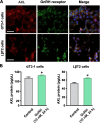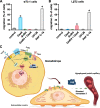AXL receptor tyrosine kinase modulates gonadotropin-releasing hormone receptor signaling
- PMID: 37828510
- PMCID: PMC10568877
- DOI: 10.1186/s12964-023-01313-y
AXL receptor tyrosine kinase modulates gonadotropin-releasing hormone receptor signaling
Abstract
Background: Gonadotropin-releasing hormone (GnRH) receptors are essential for reproduction and are expressed in numerous urogenital, reproductive, and non-reproductive cancers. In addition to canonical G protein-coupled receptor signaling, GnRH receptors functionally interact with several receptor tyrosine kinases. AXL is a receptor tyrosine kinase expressed in numerous tissues as well as multiple tumors. Here we tested the hypothesis that AXL, along with its endogenous ligand Gas6, impacts GnRH receptor signaling.
Methods: We used clonal murine pituitary αT3-1 and LβT2 gonadotrope cell lines to examine the effect of AXL activation on GnRH receptor-dependent signaling outcomes. ELISA and immunofluorescence were used to observe AXL and GnRH receptor expression in αT3-1 and LβT2 cells, as well as in murine and human pituitary sections. We also used ELISA to measure changes in ERK phosphorylation, pro-MMP9 production, and release of LHβ. Digital droplet PCR was used to measure the abundance of Egr-1 transcripts. A transwell migration assay was used to measure αT3-1 and LβT2 migration responses to GnRH and AXL.
Results: We observed AXL, along with the GnRH receptor, expression in αT3-1 and LβT2 gonadotrope cell lines, as well as in murine and human pituitary sections. Consistent with a potentiating role of AXL, Gas6 enhanced GnRH-dependent ERK phosphorylation in αT3-1 and LβT2 cells. Further, and consistent with enhanced post-transcriptional GnRH receptor responses, we found that Gas6 increased the abundance of Egr-1 transcripts. Suggesting functional significance, in LβT2 cells, Gas6/AXL signaling stimulated LHβ production and enhanced GnRH receptor-dependent generation of pro-MMP9 protein and promoted cell migration.
Conclusions: Altogether, these data describe a novel role for AXL as a modulator of GnRH receptor signaling. Video Abstract.
Keywords: Gas6; Matrix metalloproteinase 9; TAM receptor tyrosine kinase.
© 2023. BioMed Central Ltd., part of Springer Nature.
Conflict of interest statement
The authors declare no competing interests.
Figures





Similar articles
-
Growth arrest-specific gene 6 (Gas6)/adhesion related kinase (Ark) signaling promotes gonadotropin-releasing hormone neuronal survival via extracellular signal-regulated kinase (ERK) and Akt.Mol Endocrinol. 1999 Feb;13(2):191-201. doi: 10.1210/mend.13.2.0230. Mol Endocrinol. 1999. PMID: 9973250
-
Novel mechanism for gonadotropin-releasing hormone neuronal migration involving Gas6/Ark signaling to p38 mitogen-activated protein kinase.Mol Cell Biol. 2002 Jan;22(2):599-613. doi: 10.1128/MCB.22.2.599-613.2002. Mol Cell Biol. 2002. PMID: 11756555 Free PMC article.
-
Adhesion-related kinase induction of migration requires phosphatidylinositol-3-kinase and ras stimulation of rac activity in immortalized gonadotropin-releasing hormone neuronal cells.Endocrinology. 2007 Jun;148(6):2806-14. doi: 10.1210/en.2007-0039. Epub 2007 Mar 1. Endocrinology. 2007. PMID: 17332061
-
AXL/Gas6 signaling mechanisms in the hypothalamic-pituitary-gonadal axis.Front Endocrinol (Lausanne). 2023 Jun 15;14:1212104. doi: 10.3389/fendo.2023.1212104. eCollection 2023. Front Endocrinol (Lausanne). 2023. PMID: 37396176 Free PMC article. Review.
-
Therapeutic Targeting of the Gas6/Axl Signaling Pathway in Cancer.Int J Mol Sci. 2021 Sep 15;22(18):9953. doi: 10.3390/ijms22189953. Int J Mol Sci. 2021. PMID: 34576116 Free PMC article. Review.
Cited by
-
Bisecting GlcNAc modification of vesicular GAS6 regulates CAFs activation and breast cancer metastasis.Cell Commun Signal. 2025 Jan 22;23(1):39. doi: 10.1186/s12964-025-02052-y. Cell Commun Signal. 2025. PMID: 39844194 Free PMC article.
-
Recent Advances in the Understanding of Gonadotrope Lineage Differentiation in the Developing Pituitary.Neuroendocrinology. 2025;115(2):195-210. doi: 10.1159/000542513. Epub 2024 Nov 11. Neuroendocrinology. 2025. PMID: 39527929 Free PMC article. Review.
References
Publication types
MeSH terms
Substances
Grants and funding
LinkOut - more resources
Full Text Sources
Molecular Biology Databases
Research Materials
Miscellaneous

